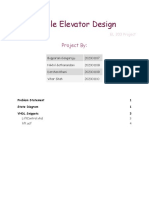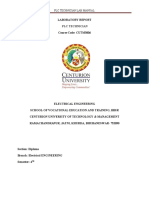0 ratings0% found this document useful (0 votes)
27 viewsAssignment 1
Using Keil IDE and assembly language, develop all modules required for a lift controller to simulate its behavior based on given specifications. The lift controller connects various sensors and actuators as shown in a diagram. Displays are updated using appropriate BCD values generated at port pins. There are basic test cases to test the design including: (1) a lift reaching floor 2 after users press buttons on floors 1 and 2, and (2) a door opening for 2 minutes or when a close button is pressed before closing. Additional test cases and assumptions used in the design should be documented. The completed project folder is to be zipped and submitted by February 2nd, 2014.
Uploaded by
Shivam ShuklaCopyright
© © All Rights Reserved
Available Formats
Download as PDF, TXT or read online on Scribd
0 ratings0% found this document useful (0 votes)
27 viewsAssignment 1
Using Keil IDE and assembly language, develop all modules required for a lift controller to simulate its behavior based on given specifications. The lift controller connects various sensors and actuators as shown in a diagram. Displays are updated using appropriate BCD values generated at port pins. There are basic test cases to test the design including: (1) a lift reaching floor 2 after users press buttons on floors 1 and 2, and (2) a door opening for 2 minutes or when a close button is pressed before closing. Additional test cases and assumptions used in the design should be documented. The completed project folder is to be zipped and submitted by February 2nd, 2014.
Uploaded by
Shivam ShuklaCopyright
© © All Rights Reserved
Available Formats
Download as PDF, TXT or read online on Scribd
You are on page 1/ 2
Using Keil IDE and using Assembly language programming develop all the modules required for the
Lift controller and simulate its behavior.
Go through the Lift controller specifications mentioned in contact session 1 of Module 1.
The various sensors and actuators are connected as per the diagram below. You can use INT0 for
buttons inside lift
For displays generate the appropriate BCD values at the port pins.
Assume that initially lift is at the ground floor.
These are the basic test cases against which the design will be tested . So please verify it from your
side also before you upload the solution
1. The user on floor 2 presses the button on floor. A user on floor 1 presses up button once the
lift starts moving.
Expected output Lift reaches maximum velocity as it reaches fine sensor of ground floor
and continues at the same speed till it reaches when Coarse Sensor 2 of floor 2 .Lift starts
moving at a low speed until it can stop when it reaches Fine sensor at floor 2. On upward
journey of lift, lift should not stop at floor 1. After the lift stops at floor 2 , then again lift will
start and stop at floor 2 .(Speed will be judged by duty cycle of PWM)
Displays are updated accordingly
2. Door is opened the door closes after 2 minutes or when Door close button is
pressed(whichever event happens first)
3. Lift will not start moving if door is open
4. A user button press inside the lift gets priority over user button press on floor.
Note: Please go through the video lectures uploaded regarding Labs to understand how user inputs
can be simulated using Keil IDE.
To be submitted
1. For ease of evaluation please submit the complete project folder for evaluation. Zip the folder.
Name the folder with your ID Number and NAME and upload on EEEZG512 site.
2. Identify the test cases that you can identify other than what is mentioned here . Use a notepad
document or Word document to write the test cases and include it in the zipped folder. Also
mention any of the assumptions you have used in the design in the same document
Last date of submission: Feb -2
nd
2014
You might also like
- Control of A Four-Level Elevator System Using A Programmable Logic Controller Experiment No. 4100% (1)Control of A Four-Level Elevator System Using A Programmable Logic Controller Experiment No. 416 pages
- Self Study: Comparative Study of Arm Cores - Armv4 To Arm Cortex100% (1)Self Study: Comparative Study of Arm Cores - Armv4 To Arm Cortex4 pages
- Lift Controller: Proff. Manish K. PatelNo ratings yetLift Controller: Proff. Manish K. Patel26 pages
- PLC Basic Progr AM: Technological University of The Philippines - TaguigNo ratings yetPLC Basic Progr AM: Technological University of The Philippines - Taguig15 pages
- Title: Design of Five-Storey Elevator Control System Based On Programmable LogicNo ratings yetTitle: Design of Five-Storey Elevator Control System Based On Programmable Logic5 pages
- Control System For Experimental Model of Electric Elevator: April 2015No ratings yetControl System For Experimental Model of Electric Elevator: April 20156 pages
- Control of A Four Level Elevator System Using A Programmable Logic Controller Experiment No 4 PDFNo ratings yetControl of A Four Level Elevator System Using A Programmable Logic Controller Experiment No 4 PDF16 pages
- ME-Electives 4-Experiment-4 Multi-Track Gravity Feed Magazine PDFNo ratings yetME-Electives 4-Experiment-4 Multi-Track Gravity Feed Magazine PDF7 pages
- ME-Electives 4-Experiment-5 Multi-Track Gravity Feed MagazineNo ratings yetME-Electives 4-Experiment-5 Multi-Track Gravity Feed Magazine7 pages
- WSMB2022 - TP Final Esp - Electronics - V2No ratings yetWSMB2022 - TP Final Esp - Electronics - V225 pages
- Our Elevator Has The Basic Function That All Elevator Systems Have, Such As Moving Up and Down, Open and Close Doors, and of Course, Pick Up PassengersNo ratings yetOur Elevator Has The Basic Function That All Elevator Systems Have, Such As Moving Up and Down, Open and Close Doors, and of Course, Pick Up Passengers2 pages
- Ejercicio en Clase PLC - KEVIN VELASTEGUI - DANNY TOPANo ratings yetEjercicio en Clase PLC - KEVIN VELASTEGUI - DANNY TOPA10 pages
- Experiment 5 Auto Operation of 2 Devices using Timer(1)No ratings yetExperiment 5 Auto Operation of 2 Devices using Timer(1)4 pages
- The Five Floor Elevator Control System Design BaseNo ratings yetThe Five Floor Elevator Control System Design Base7 pages
- Sample Solution Exercise PLC ProgrammingplcNo ratings yetSample Solution Exercise PLC Programmingplc13 pages
- iOS Programming For Beginners: The Ultimate iOS App Developer's GuideFrom EverandiOS Programming For Beginners: The Ultimate iOS App Developer's Guide3/5 (1)
- Objective: Classification Using ID3 and C4.5 Algorithms TasksNo ratings yetObjective: Classification Using ID3 and C4.5 Algorithms Tasks8 pages
- Self Study: Atmel Atmega128 Architecture: Anupama KR & Meetha.V.Shenoy Embedded System Design 8051100% (1)Self Study: Atmel Atmega128 Architecture: Anupama KR & Meetha.V.Shenoy Embedded System Design 80515 pages
- Home Work 2: Dead Line March 10 - 8 Am Both Questions Are To Be AttemptedNo ratings yetHome Work 2: Dead Line March 10 - 8 Am Both Questions Are To Be Attempted1 page











































































